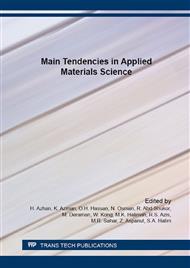p.183
p.189
p.193
p.199
p.205
p.210
p.216
p.225
p.230
Role of Ionics Surfactant in Synthesizing Cerate-Zirconate Ceramic Powder
Abstract:
BaCe0.54Zr0.36Y0.1O2.95 (denoted as BCZY10) ceramic powder was synthesized by a modified sol-gel method using metal nitrate salts as precursors. The samples were prepared using two different types of surfactants which are cationic surfactant of hexadecyldimethylammonium bromide (HTAB), nonionic surfactant of polyoxyethylene (10) oleyl ether (Brij 97), and sample without surfactant as a control. All samples were labeled as S1, S2, and S3 respectively. They were dried and calcined at T=325 °C and T=1100 °C accordingly. Chemicals bonding of the compound were analyzed using Fourier transform infrared (FTIR) spectrometry and their phase formation was identified by X-Ray Diffractometer (XRD). All the dried samples showed the adsorption peak at 3200-3700 cm-1 that related to the overlapping of OH stretching originated from –OH terminal group and N-H stretching vibrations. The peaks appeared at 1620-1640 cm-1 can be assigned to C=O stretching and at 1380-1450 cm-1 can be attributed for N-H bending vibration. The adsorption peak ≈500 cm-1 of metal-oxygen bond for all the calcined samples became pronounces indicating that the metal complexes were transformed to metal oxides. XRD results confirmed that S2 and S3 formed a single-phase of Ba (Ce,Zr)O3 perovskite type-oxide and S1 consists of multi-phases compound which are dominated by BaCeO3, and BaZrO3. Therefore, the used of different type of surfactant was found to give a significant effect on the synthesizing single-phase of BCZY10 ceramics compound.
Info:
Periodical:
Pages:
205-209
Citation:
Online since:
March 2016
Keywords:
Price:
Сopyright:
© 2016 Trans Tech Publications Ltd. All Rights Reserved
Share:
Citation:


